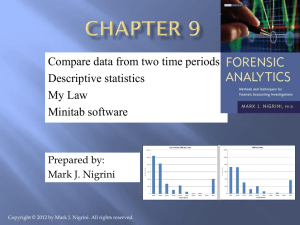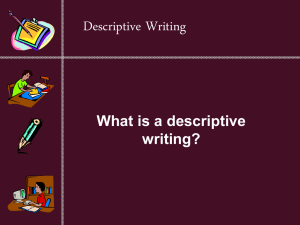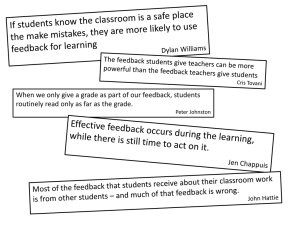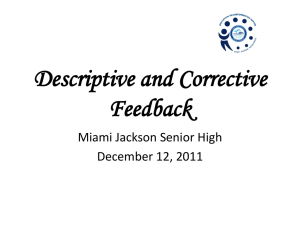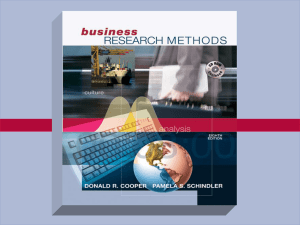Chapter 1 - Introduction to Modeling
advertisement
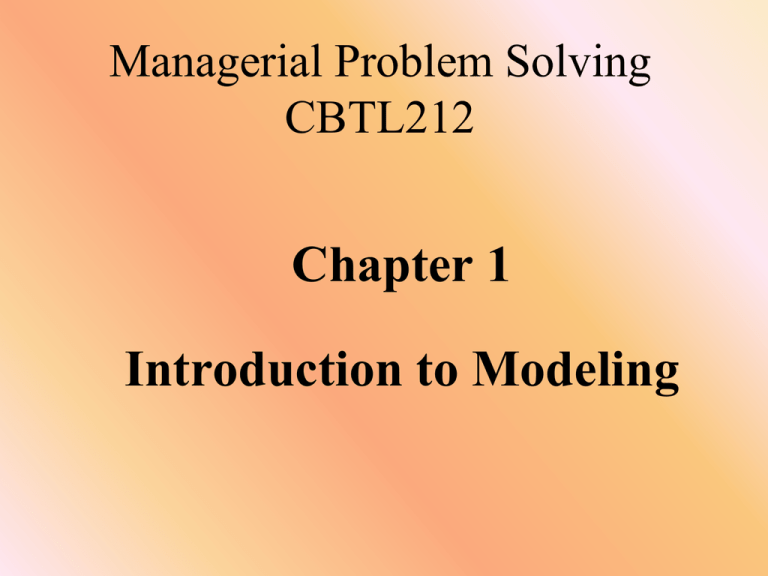
Managerial Problem Solving CBTL212 Chapter 1 Introduction to Modeling 1.1 Introduction • purpose of course is to 1. expose you to a variety of problems that have been solved successfully with management science methods and to 2. give you experience in modeling these problems in the Excel spreadsheet package. Introduction cont’ • Key to virtually every management science application is a mathematical model. • a mathematical model is a quantitative representation, or idealization, of a real problem. • Represented or expressed in terms of mathematical expressions (equations and inequalities) or as a series of interrelated cells in a spreadsheet. Introduction cont’ • Purpose of a mathematical model represent the essence of a problem in a concise form. This has several advantages: 1. it enables a manager to understand the problem better [scope, solutions and data requirements] Introduction cont’ 2. allows analysts to employ a variety of the mathematical solution procedures that have been developed over the past halfcentury. [ usually computer intensive] 3. the modeling process itself, if done correctly, often helps to “sell” the solution to the people who must work with the system that is eventually implemented. 1.2 A Waiting-Line Example • A mathematical model is a set of mathematical relationships that represent, or approximate, a real situation. • Descriptive models - Models that simply describe a situation • Optimization models - models that suggest a desirable course of action A Descriptive Model Example: Waiting line or Queueing problem • Consider a shop with a single cash register (till). • The manager first wants to build a model that reflects the current situation at the store. (descriptive model) • Later, he will alter the model to predict what might make the situation better. (optimization model) A Descriptive Model cont’ Single Line Waiting System Customer gets served at the till Customer arrives Waiting line Customer leaves A Descriptive Model cont’ • To describe the current situation, the manager realizes that there are two important inputs to the problem: 1. the arrival rate of potential customers to the store and 2. the rate at which customers can be served by the single cashier. A Descriptive Model cont’ • Logic behind problem: – as the arrival rate increases and/or (input) – the service rate decreases, (input) – the waiting line will tend to increase and (output) – each customer will tend to wait longer in line (output) A Descriptive Model cont’ • By making several simplifying assumptions about the nature of the arrival and service process at the store we can relate the inputs to the outputs using a mathematical model i.e. an equation A Descriptive Model cont’ • A is the arrival rate of customers per minute, • S is the service rate of customers per minute, and • W is the average time a typical customer waits in line A Descriptive Model cont’ • We must determine how the manager can obtain the inputs he needs. There are actually three inputs: – (1) the arrival rate A, (stopwatch) – (2) the service rate S, and (stopwatch) – (3) the number in the store, labeled N, that will induce future customers not to enter. (observation) A Descriptive Model cont’ Descriptive queueing model for convenience store Inputs Arrival rate (customers per minute) Service rate (customers per minute) Maximum customers (before others go elsewhere) Outputs Average number in line Average time (minutes) spent in line Percentage of potential arrivals who don't enter 0.5 0.4 5 2.22 6.09 27.1% A Descriptive Model cont’ • These values indicate: – that slightly more than 2 customers are waiting in line on average, – an average customer waits slightly more than 6 minutes in line, and – about 27% of all potential customers do not enter the store at all (due to the perception that waiting times will be long). A Descriptive Model cont’ • The power of the model is that it allows the manager to ask many What-If questions. • For example, what if he could somehow speed up the cashier, say, from 2.5 minutes per customer to 1.8 minutes per customer? – 1/1.8 = 0.556 customers per minute A Descriptive Model cont’ Descriptive queueing model for convenience store Inputs Arrival rate (customers per minute) Service rate (customers per minute) Maximum customers (before others go elsewhere) Outputs Average number in line Average time (minutes) spent in line Percentage of potential arrivals who don't enter 0.5 0.556 5 1.41 3.22 12.6% A Descriptive Model cont’ • what if he could somehow speed up the cashier, say, from 2.5 minutes per customer to 1.25 minutes per customer? – 1/1.25 = 0.8 customers per minute A Descriptive Model cont’ Descriptive queueing model for convenience store Inputs Arrival rate (customers per minute) Service rate (customers per minute) Maximum customers (before others go elsewhere) 0.5 0.8 5 Outputs Average number in line Average time (minutes) spent in line 0.69 1.42 Percentage of potential arrivals who don't enter 3.8% A Descriptive Model cont’ • As the manager increases the service rate, the output measures improve more than he might have expected • the manager should examine the reasonableness of the assumptions – test it!! An Optimization Model • A model that suggest a desirable course of action • Reflects economic information, such as: – the cost of speeding up service, – the cost of making customers wait in line, or – the cost of losing customers. An Optimization Model cont’ • Assume that the manager can do one of three things: – Decision (1) leave the system as it is, – Decision (2) hire a second person to help the first cashier process customers more quickly • average service time goes from 2.5 to 1.8 minutes – Decision (3) lease a new model of cash register that will speed up the service process significantly. • Average service time goes from 2.5 to 1.25 minutes An Optimization Model cont’ • He needs to examine three types of costs: 1. The first is the cost of hiring the extra per son or leasing the new cash register. – hourly wage for the extra person is $8, and the – cost to lease a new cash register (converted to a per-hour rate) is $11 per hour. An Optimization Model cont’ 2. The second type of cost is the “cost” of making a person wait in line. – a customer who has to wait a long time might not return. – This cost is difficult to estimate on a perminute or per-hour basis, but we assume it’s approximately $13 per customer per hour in line. An Optimization Model cont’ 3. The opportunity cost for customers who decide not to enter the store. – The store loses not only their current revenue but also potential future revenue if they decide never to return. – Lets assume it’s approximately $25 per lost customer. 1 2 3 4 5 Decision queueing model for convenience store Inputs Arrival rate (customers per minute) Service rate (customers per minute) Maximum customers (before others go 6 elsewhere) 7 8 Cost of extra person per hour 9 Cost of leasing new cash register per hour 10 Cost per customer per hour waiting in line 11 Cost per customer who doesn't enter the store 12 13 Outputs 14 Average number in line 15 Average time (minutes) spent in line 16 Percentage of potential arrivals who don't enter 17 18 Cost information 19 Cost of extra person per hour 20 Cost of leasing new cash register per hour 21 Cost per hour of waiting time 22 Cost per hour of lost customers 23 24 Total cost per hour Decision 1 0.5 0.4 Decision 2 0.5 0.556 Decision 3 0.5 0.8 5 5 5 $0 $0 $13 $25 $8 $0 $13 $25 $0 $11 $13 $25 2.22 6.09 27.1% 1.41 3.22 12.6% 0.69 1.42 3.8% $0 $0 $28.87 $203.29 $8 $0 $18.31 $94.52 $0 $11 $8.91 $28.52 $232.16 $120.82 $48.43 1.3 MODELING VERSUS MODELS • Learning specific models is essentially a memorization process—memorizing the details of a particular model, such as the transportation model, and possibly learning how to “trick” other problems into looking like a transportation model. • Modeling, on the other hand, is a process, where you abstract the essence of a real problem into a model, spreadsheet or 1.4 THE SEVEN-STEP MODELING PROCESS Step 1: Problem Definition – The analyst first defines the organization’s problem. – Defining the problem includes specifying the organization’s objectives and the parts of the organization that must be studied before the problem can be solved 1.4 THE SEVEN-STEP MODELING PROCESS cont’ Step 2: Data Collection – the analyst collects data to estimate the value of parameters that affect the organization’s problem – gather exactly the right data and put the data into an appropriate and consistent format for use in the model. • • • asking questions of key people (such as the accountants) throughout the organization, studying existing organizational databases, and performing time-consuming observational studies of the organization’s processes 1.4 THE SEVEN-STEP MODELING PROCESS cont’ Step 3: Model Development • Analytical models - Models such as the equation for W, where you use an equation to relate inputs such as A and S to outputs such as • Simulation model (for very complex problems), which enables you to approximate the behavior of the actual system W 1.4 THE SEVEN-STEP MODELING PROCESS cont’ Step 3: Model Development cont’ – Most good models (where “good” really means useful) capture the essence of the problem without getting bogged down in less important details. – approximations of the real world, not mirror images in every last detail. 1.4 THE SEVEN-STEP MODELING PROCESS cont’ Step 4: Model Verification – analyst now tries to determine whether the model developed in the previous step is an accurate representation of reality. – A first step in determining how well the model fits reality is to check whether the model is valid for the current situation Step 4: Model Verification cont’ • 2 Causes for unexpected outputs 1. the model could simply be a poor approximation of the actual situation. • In this case, the analyst must refine the model until it lines up more accurately with reality. 2. the model might be fine, but the analyst’s intuition is not very good – provide wrong prediction 1.4 THE SEVEN-STEP MODELING PROCESS cont’ Step 5: Optimization and Decision Making – Given a model and a set of possible decisions, the analyst must now choose the decision or strategy that best meets the organization’s objectives – maximizing profit or minimizing cost. 1.4 THE SEVEN-STEP MODELING PROCESS cont’ Step 6: Model Communication to Management – The analyst presents the model and the recommendations from the previous step to the organization – the analyst might present several alternatives and let the organization choose the best one. – The best strategy for successful presentation is to involve key people in the organization – make the model as intuitive and user-friendly as possible 1.4 THE SEVEN-STEP MODELING PROCESS cont’ Step 7: Model Implementation – If the organization has accepted the validity and usefulness of the study, the analyst then helps to implement its recommendations. – The implemented system must be monitored constantly (and updated dynamically as the environment changes) to ensure that the model enables the organization to meet its objectives. 1.6 WHY STUDY MANAGEMENT SCIENCE? • Management science is an important area and highly trained analysts are needed to solve the large and complex problems faced by the business world 1.6 WHY STUDY MANAGEMENT SCIENCE? cont’ The following are some of the reasons for this new-found relevance: The modeling approach emphasized throughout this book is an important way to think about problems in general, not just the specific problems we discuss. This approach forces you to think logically 1.6 WHY STUDY MANAGEMENT SCIENCE? cont’ Management science is admittedly built around quantitative skills—it deals primarily with numbers and relationships between numbers No matter what your spreadsheet abilities are when you enter this course, by the time you’re finished, you’ll be a proficient spreadsheet user. . 1.6 WHY STUDY MANAGEMENT SCIENCE? cont’ Management science modeling helps you develop your intuition, and it also indicates where intuition alone sometimes fails.
